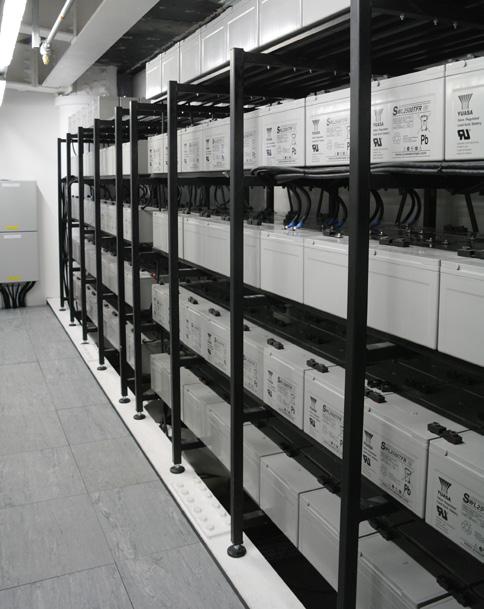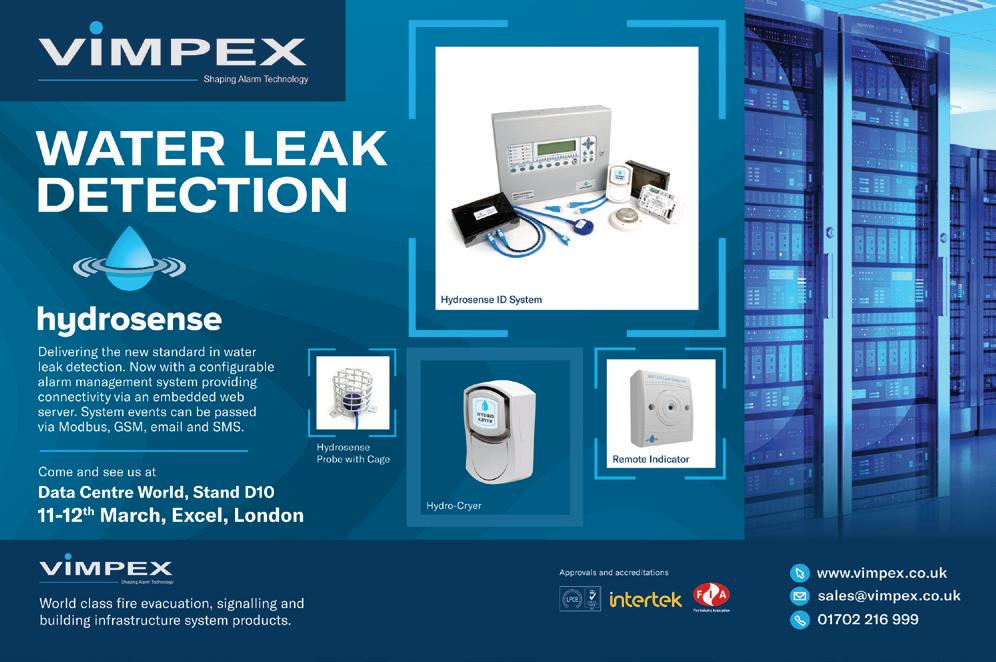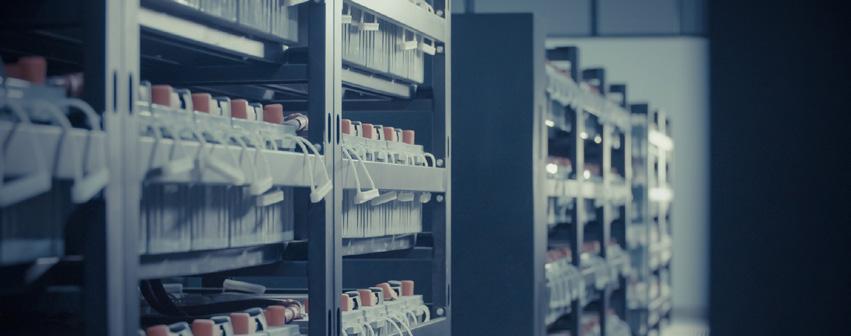
14 minute read
Standby Power/UPS
from DCR March 2020
To UPS hire or not to UPS hire?
Adem Kemal BEng (Hons) MSc MIET, service director at Levant UPS Ltd, explores the benefits (and pitfalls) of hiring your UPS equipment.
Advertisement
As demand for global round the clock IT services increases in the form of multi-billion-pound web-based businesses, so does our reliance on uninterrupted power in order to access these services 24-7 from anywhere in the world.
With changing customer demand and unwillingness to commit to high capital expenditure during these turbulent economic times, UPS hire is becoming an increasingly popular choice for those clients who are wanting to exploit the flexibility and non-committal aspect of leasing UPS systems, either on a short or long-term basis.
UPS failures, whilst less common on reliable well-maintained equipment, can and do occur. As with anything else in life, the likelihood is greatly increased with age. For those clients who need immediate access to reliable power protection systems whilst they assess their requirements for either repair or replacement of the failed equipment, a hire UPS makes perfect sense.
Costly repairs of ageing equipment can often lead to a waste of resources, whilst valuable time to assess the requirements and needs for future equipment can ensure that the wrong decision is not taken when
selecting the appropriate replacement machines. All diligent companies will understand that their UPS choice is one of the most important decisions that they will ever make when it comes to guaranteeing and protecting the seamless operation of their business-critical processes.
As with most other aspects of any business, the majority of corporate decisions come down to cost versus necessity. Of course, cost cannot just be evaluated in terms of initial outlay, but also in terms of the cost to the business should equipment failure occur and the potential for this to disrupt business activities. The ability to hire a self-contained complete UPS setup means minimum downtime during connection and commissioning, versus the high costs of complicated repairs with no guarantee of a first-time fix on the stricken UPS. Or even worse, a loss of customer confidence in your company. In recent years, we have seen the widespread and damaging effects of catastrophic failure of IT infrastructure such as that experienced by British Airways and TSB bank. In both cases, severe damage was caused to the brand, not to mention the loss of revenue and huge fines imposed by industry regulators. In the case of BA, the outage was estimated to cost the airline £58 million in passenger compensation claims alone. Whilst TSB has revealed that their massive IT failure cost the bank £330 million, with 80,000 customers switching their account to a competitor. Both cases highlight the ramifications of critical equipment downtime to a heavily IT dependent business.
Furthermore, hiring your UPS means that you are able to operate your power protection system according to market demand. How many times have you seen a site running a high capacity UPS on as little as 5% load? This signifies a vast waste of capital as predicated future expansion can often fail to materialise in quite the way that earlier business predictions may have indicated. Running such large capacity machines on little load is extremely inefficient and having the option to off-hire such a system and replace it with a smaller machine is particularly advantageous. The ability to expand and contract with market conditions is a huge benefit of hiring your UPS system, with extremely low capital expenditure costs in order to do so.
Whilst hiring a UPS has many advantages, there are of course several factors to consider in choosing a suitable vendor. Selecting a supplier with a proven brand of UPS and extensive experience of connecting their hire sets into pre-existing electrical networks (which are unlikely to have given any prior design consideration to this eventuality) is crucial. A competent vendor will be able to identify a suitable point of entry into your existing on-site distribution network with little or no negative impact. The provider should demonstrate that they are able to understand in detail your business requirements and how you require the equipment to perform. This may be in the form of output voltage, frequency, battery autonomy or any other relevant factors.
A good hire company will offer a comprehensive witness testing procedure for your engineering management and consultants, to prove correct and adequate operation of the hire system under simulated load bank tests with mains failure.
The pitfalls of UPS hire mainly centre on clients being able to identify a specific set of criteria for which they want the UPS to conform to. In some instances, non-technical individuals are assigned to source a hire provision, only to be completely out of their depth in ensuring with the provider that the equipment can operate as needed on-site. This can be mitigated with effective communication, cooperation between the provider and client and a conscientious approach by the installer to ensuring that all relevant matters are discussed before any equipment is delivered to site.
While hire UPS systems have long been the choice of clients looking to bridge downtime created by failure of their own UPS assets, many clients are now looking to hire UPS systems with a long-term lease approach which affords them flexibility, low capital outlay and peace of mind to mould their power protection system according to their business needs. This reduces the need to make far-off predictions about future capacity and the potential waste of funds should these expectations not be realised further down the line.

The chink in your uninterruptible armour

When the mains fail, the only thing protecting the critical load is your UPS and your batteries. This is really the only time you will find out if your batteries are up to the job. The consequences of battery failure in this scenario are far reaching, resulting in disruption and damaged reputations. For some organisations in the financial sector it may mean fines, for medical facilities power failure can be literally life or death.
Therefore, it is essential that VRLA batteries are properly commissioned and maintained correctly. Normally, VRLA batteries have a design life of either three to five years or 10-12 years. However, in reality, this can be a lot less even if they are maintained properly.
Regular maintenance and service visits for a UPS include a visual check of the batteries and this inspection is essential. Maintenance staff are looking out for any signs of corrosion, swelling of the blocks and any indication of leaking or other damage. However, they can’t see inside a battery with a visual inspection.
Impedance testing once per year is therefore important. Here an AC current is applied to each battery and the internal impedance measured and recorded. This tests each VRLA block and provides a good indication of the general overall state of the batteries.
However, impedance testing doesn’t show how long batteries will last. Even if an impedance test was satisfactory, the application of a real load can result in batteries collapsing quickly if there are issues.
For this reason, best practice is to have two maintenance visits per year and to carry out an impedance test to assess the overall health of the batteries during the first visit, and a full discharge test during the second visit.
The discharge test enables assessment of the batteries against a replicated load e.g. temporary load bank. The critical load will need to be transferred to bypass during the assessment, with results showing precisely how the batteries will perform and for how long. Discharge testing in this way also tests the overall installation, batteries, cables and Andrew Skelton, operations director at Centiel UK Ltd highlights why your UPS is only as good at your batteries.
all connections to ensure they are working properly.
Most facilities will conduct a full discharge test during the initial installation of the UPS system. The challenge is that less than 5% of organisations then go on to commission a regular annual discharge test of their batteries. This may be because of the additional maintenance costs involved, however, the consequences of finding out too late that batteries will not support your critical load in an emergency for the required runtime, may cost far more.
Some people may be concerned that discharging batteries may reduce their cycling ability. However, VRLA batteries are designed for approximately 500 cycles, so an annual discharge under test conditions will have little to no effect on their performance.
Switching the critical load to bypass on raw mains for the period of the test, does however carry a small risk and this disruption is often met unfavourably with organisations. Although, again, compare this small risk with the much greater risk of the UPS not being fully functional in an emergency. To mitigate the small risk, you can secure grid onto your building generator or a temporary hire generator, which can pick up the load if there is a mains power cut during the test.
Carrying out both an impedance and discharge test on batteries each year provides detailed information so organisations can ‘know their batteries’. Deterioration can be monitored over time, and you would expect to see a small deterioration each year over the life of your batteries. This information helps organisations make informed decisions about the timing of replacements. Having a clear picture of battery health in this way can ensure action taken to optimise functionality and minimise risk of failure.
There is always a small risk associated with any maintenance of a UPS system. However, the risk of the UPS and batteries not performing properly because they have not been tested thoroughly far outweighs this. Your UPS is only as good as your batteries: get them checked on a regular basis. Your power depends on it!


The smart way to unlock data centre power

Data centre operators will cut costs and enhance system resilience if they ditch their doubts about demand side response, says Riello UPS managing director Leo Craig.
Much of the recent focus on 5G has fallen on the fierce debate about the involvement (or not) of Huawei in upgrading the UK’s wireless telecoms network. But there are real questions for us in the data centre sector to consider too. The rollout of 5G places huge pressure to provide the promised low latency processing. And all that processing comes at a great cost – power.
Reading a recent report from the Uptime Institute, it staggered me to learn that every time footballer Cristiano Ronaldo (or more likely his PR reps) post on Instagram, his 200 million-plus followers consume 30 megawatt hours of energy just to view it.
Data centres are already some of the world’s biggest energy users. Industry body TechUK claims if you combine commercial and in-house data centres, they account for 2% of all UK electricity use.
The biggest facilities have annual energy bills of £3 million a year and consume the equivalent power of 300,000 homes, roughly the populations of Leicester, Sunderland or Belfast. Winds of change This all comes at a time where our electricity network is going through huge changes. Last year saw more UK electricity generated from zero-carbon sources (48.5%) than fossil fuels (43%) for the first time.
Our growing reliance on renewables such as wind and solar, which by nature are more unpredictable than coal or gas, poses major challenges for National Grid. Namely balancing supply with demand and ensuring a stable grid frequency.
It is turning to smart grids, energy storage and mechanisms such as demand side response (DSR) as the answer. The latter incentivises customers to store power and shift their energy use from busy to offpeak periods.
It rewards participants with reduced grid tariffs and energy bills, as well as offering opportunities to sell surplus electricity back into the grid.
Data centres appear an ideal candidate for DSR. They have sizeable battery-based uninterruptible power supplies providing the perfect tool – on paper – to store energy and feed it back into the grid.
But so far operators have been somewhat reluctant to take the plunge. In an industry where downtime and even the slightest service interruption can cost thousands or even millions of pounds, it’s understandable that they’re unwilling to use their expensive UPS and batteries – their de facto last line of defence – for anything else.
Operators see it as a big risk that isn’t worth the reward. But is that argument true anymore?
The Master+ model We’re working alongside RWE Supply & Trading, the energy trading arm of Germany’s largest electricity supplier RWE, on a pilot project that transforms a reactive data centre UPS into a proactive ‘virtual power plant’ that can participate in DSR whilst at the same time enhancing, rather than undermining, system resilience.
It involves one of our Master+ units fitted with a special rectifier that enables power to flow both from and to the grid.
The smart grid-ready UPS is backed with premium lead-acid or
lithium-ion batteries. It’s also equipped with RWE’s dedicated monitoring and communications software, which allow for real-time condition analysis and two-way interaction with the grid.
Battery capacity is split into two distinct roles. To start, there’s a section purely providing the standard UPS safety net of emergency backup power in the event of a mains failure. The remaining ‘commercial’ batteries feed stored electricity into the Firm Frequency Response DSR scheme, which helps maintain grid frequency within the safe range of 49.5-50.5 Hz.
If there’s a power cut, any remaining energy in the ‘commercial’ batteries tops up the primary backup, offering users longer autonomy.
Rethinking the role of a UPS Think back to the main stumbling block data centre operators have about DSR. Using a UPS’s batteries adds an unacceptable layer of risk.
But it’s difficult to monitor traditional sealed lead-acid batteries effectively unless you install hugely-expensive battery monitoring and management systems. Hand on heart, can you be 100% sure they’ll work when you really need them?
With the Master+ model, the mandatory battery monitoring system alerts you when there’s any deterioration. It identifies blocks that need replacing. So rather than undermining your resilience, it actually improves it.
There are other benefits for operators too. RWE Supply & Trading significantly subsidises the cost of the more expensive premium batteries, reducing the upfront investment. It also takes on the risk of trading on the energy market.
So far, tests at our two pilot sites – one at RWE’s HQ in Essen, Germany, the other here in the UK – have proved positive. Based on a data centre with a 1 MW load and batteries providing 10 minutes autonomy plus a 1 MWh ‘commercial’ segment, installation costs are roughly a fifth lower than a standard UPS, thanks to the subsidised batteries.
While the monitoring software reduces ongoing maintenance costs compared against time-consuming manual servicing, these ongoing savings would add up to tens of thousands of pounds over the typical 10-15 year lifespan of a UPS.
Then depending on the data centre’s location, operators could also save up to £6,000 per MW every year through reduced grid tariffs. The August blackout: Sign of things to come? Think back to the events of 9 August last year when lightning strikes saw two power stations go offline. The resulting loss of generation sent grid frequency tumbling, triggering load shedding that saw 1.1 million people cut off to save the rest of the electricity network.
Thankfully, the blackout was short-lived. Frequency returned to safe operating limits inside four minutes, with power fully-restored inside an hour.
One of the reasons for this was that National Grid deployed 1 GW of backup power to plug the shortfall in generation. Nearly half of this reserve capacity (472 MW) came from battery storage – around 200 MW from National Grid’s own portfolio, with the remainder from various DSR contributors and aggregators.
National Grid already spends around £170 million a year on frequency response contracts. One likely fallout from 9 August is that the system operator will significantly increase its reserve capacity to deal with similar incidents in the future.
As we transition towards a more distributed, renewables-led electricity system, battery storage and demand side response will play an increasingly important role in keeping the lights on. And with solutions such as the Master+ model now making energy storage not just feasible but advantageous for data centres, there’s no excuse for operators to carry on sitting on the sidelines.
It’s time to harness the true power of their UPS systems and batteries. They get the financial and performance gains while boosting the security of supply for society as a whole. Sounds like a smart move to us.
Riello UPS and RWE Supply & Trading will be explaining more about the Master+ smart grid-ready UPS concept during a special seminar at Data Centre World. Join them in the Facilities and Critical Equipment arena from 10:45-11:10 on Wednesday 11 March.
The Riello UPS team will be on-hand throughout DCW on stand D920 to discuss its entire range of uninterruptible power supplies and industry-leading maintenance support. This year’s show includes the official UK launch of its extended Multi Power range of modular UPS.











